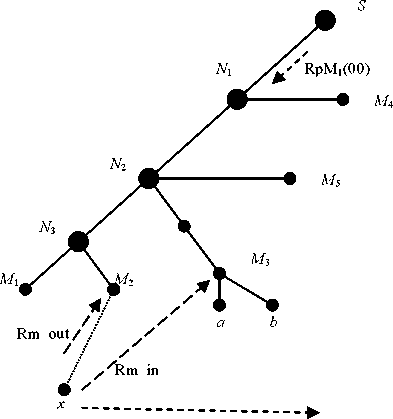In the second scenario a DBT change has happened because of roaming of mobile node x.
This scenario can happen in one of the following cases:
J Case 1 : the mobile receiver x is the last receiver attached to oLMR and it is not
the first mobile receiver attached to the nLMR.
J Case 2: the mobile receiver x is not the last receiver attached to oLMR but it is
the first mobile receiver attached to the nLMR.
J Case 3: the mobile receiver x is the last receiver attached to oLMR and it is the
first mobile receiver attached to the nLMR.
All of these cases will cause a DBT update, including BNRs update and MFTs update at
BNRs.

Figure 5.1 Roaming process in (case 1)
|
Nodes |
MFTs | |
|
Before x join |
Afterx join | |
|
S (Source) |
MTI | IP_N1 |
unchanged |
|
N1 |
MTI | IP_N2 &IP_M4 |
unchanged |
|
N2 |
MTI | IP_N3 , IP_M3, IP_M5 |
MTI | IP_M1 , IP_M5, IP_M5 |
|
N3 |
MTI | IP_M1 & IP_M2 |
non BNR |
Roaming messages (Rm out, Rm in)
Moving direction
Starting with case 1, Figure 5.1 shows this case; when roaming is transport to the
receivers, it will send an Rm_out message towards its oLMR (M2). Upon receiving this
message and checking its MDT, x’s oLMR (M2) will be aware that it will no longer be a
multicast branch. As a result, N3 will delete its M2 entry in its MFT for the multicast
106
More intriguing information
1. The name is absent2. Skill and work experience in the European knowledge economy
3. Towards a framework for critical citizenship education
4. The name is absent
5. The name is absent
6. The Evolution
7. Evolution of cognitive function via redeployment of brain areas
8. The name is absent
9. The name is absent
10. The name is absent